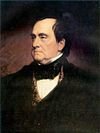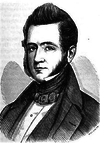It has been requested that the title of this article be changed to List of governors of Michigan . Please see the relevant discussion on the discussion page. The page should not be moved unless the discussion is closed; summarizing the consensus achieved in support of the move. |
| Governor of Michigan | |
|---|---|
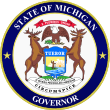 Seal of the Governor | |
 Flag of the Governor | |
| Style | Her Excellency [1] |
| Status | |
| Residence | Michigan Governor's Mansion |
| Term length | Four years, renewable once |
| Precursor | Governor of Michigan Territory |
| Inaugural holder | Stevens T. Mason |
| Formation | November 3, 1835 |
| Deputy | Lieutenant Governor of Michigan |
| Website | www |
The Governor of Michigan is the head of the executive branch of Michigan's state government and serves as the commander-in-chief of the state's military forces. [2] The governor has a duty to enforce state laws; [3] the power to either approve or veto appropriation bills passed by the Michigan Legislature; [4] the power to convene the legislature; [5] and the power to grant pardons, except in cases of impeachment. [6] He or she is also empowered to reorganize the executive branch of the state government. [7]
Michigan has a republican form of government with three branches of government: the executive branch consisting of the Governor of Michigan and the other independently elected constitutional officers; the legislative branch consisting of the House of Representatives and Senate; and the judicial branch consisting of the one court of justice. The state also allows direct participation of the electorate by initiative, referendum, recall, and ratification.

A commander-in-chief, sometimes also called supreme commander, is the person that exercises supreme command and control over an armed forces or a military branch. As a technical term, it refers to military competencies that reside in a country's executive leadership – a head of state or a head of government.

The Michigan National Guard consists of the Michigan Army National Guard and the Michigan Air National Guard.
Contents
- Governors
- Governors of the Territory of Michigan
- Governors of the State of Michigan
- Other high offices held
- Living former governors of Michigan
- Notes
- References
Michigan was originally part of French and British holdings, and administered by their colonial governors. After becoming part of the United States, numerous areas of what is today Michigan were originally part of the Northwest Territory, Indiana Territory and Illinois Territory, and administered by territorial governors. In 1805, the Michigan Territory was created, and five men served as territorial governors, until Michigan was granted statehood in 1837. Forty-eight individuals have held the position of state governor. The first female governor, Jennifer Granholm, served from 2003 to 2011.

The Northwest Territory in the United States was formed after the American Revolutionary War, and was known formally as the Territory Northwest of the River Ohio. It was the initial post-colonial Territory of the United States and encompassed most of pre-war British colonial territory west of the Appalachian mountains north of the Ohio River. It included all the land west of Pennsylvania, northwest of the Ohio River and east of the Mississippi River below the Great Lakes. It spanned all or large parts of six eventual U.S. States. It was created as a Territory by the Northwest Ordinance July 13, 1787, reduced to Ohio, eastern Michigan and a sliver of southeastern Indiana with the formation of Indiana Territory July 4, 1800, and ceased to exist March 1, 1803, when the southeastern portion of the territory was admitted to the Union as the state of Ohio, and the remainder attached to Indiana Territory.

The Indiana Territory was created by a congressional act that President John Adams signed into law on May 7, 1800, to form an organized incorporated territory of the United States that existed from July 4, 1800, to December 11, 1816, when the remaining southern portion of the territory was admitted to the Union as the state of Indiana. The territory originally contained approximately 259,824 square miles (672,940 km2) of land, but its size was decreased when it was subdivided to create the Michigan Territory (1805) and the Illinois Territory (1809). The Indiana Territory was the first new territory created from lands of the Northwest Territory, which had been organized under the terms of the Northwest Ordinance of 1787.
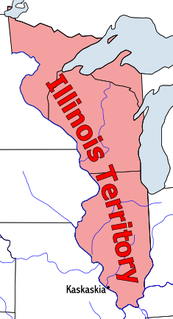
The Territory of Illinois was an organized incorporated territory of the United States that existed from March 1, 1809, until December 3, 1818, when the southern portion of the territory was admitted to the Union as the State of Illinois. Its capital was the former French village of Kaskaskia.
After Michigan gained statehood, governors held the office for a two-year term, until the 1963 Michigan Constitution changed the term to four years. The number of times an individual could hold the office was unlimited until a 1992 constitutional amendment imposed a lifetime term limit of two four-year governorships. The longest-serving governor in Michigan's history was William Milliken, who was promoted from lieutenant governor after Governor George W. Romney resigned, then was elected to three further successive terms.
A term limit is a legal restriction that limits the number of terms an officeholder may serve in a particular elected office. When term limits are found in presidential and semi-presidential systems they act as a method of curbing the potential for monopoly, where a leader effectively becomes "president for life". This is intended to protect a democracy from becoming a de facto dictatorship. Sometimes, there is an absolute or lifetime limit on the number of terms an officeholder may serve; sometimes, the restrictions are merely on the number of consecutive terms he or she may serve.
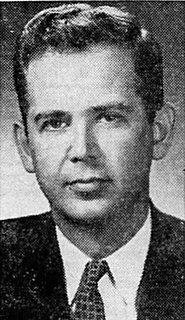
William Grawn Milliken, is an American politician who served as the 44th Governor of Michigan as a member of the Republican Party. He is the longest serving governor in Michigan history, serving from 1969 to 1983.

George Wilcken Romney was an American businessman and Republican Party politician. He was chairman and president of American Motors Corporation from 1954 to 1962, the 43rd Governor of Michigan from 1963 to 1969, and the United States Secretary of Housing and Urban Development from 1969 to 1973. He was the father of Governor of Massachusetts, 2012 Republican presidential nominee and United States Senator from Utah Mitt Romney, husband of 1970 U.S. Senate candidate Lenore Romney, and grandfather of current Republican National Committee chair Ronna McDaniel.







